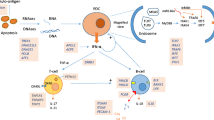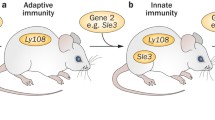Abstract
Purpose of Review
Systemic lupus erythematosus (SLE) is a multisystem autoimmune disease known for its clinical heterogeneity. Over time, new insights into the complex genetic origin of SLE have started to explain some of this clinical variability. These findings, reviewed here, have also yielded important understanding in the immune mechanisms behind SLE pathogenesis.
Recent Findings
Several new monogenic disorders with lupus-like phenotype have been described. These can be organized into physiologic pathways that parallel mechanisms of disease in SLE. Examples include genes important for DNA damage repair (e.g., TREX1), nucleic acid sensing and type I interferon overproduction (e.g., STING, TREX1), apoptosis (FASLG), tolerance (PRKCD), and clearance of self-antigen (DNASE1L3).
Summary
Further study of monogenic lupus may lead to better genotype/phenotype correlations in SLE. Eventually, the ability to understand individual patients according to their genetic profile may allow the development of more targeted and personalized approaches to therapy.
Similar content being viewed by others
References
Tsokos GC. Systemic lupus erythematosus. N Engl J Med. 2011;365:2110–21. doi:10.1056/NEJMra1100359.
Marlow AA, Peabody Jr HD, Nickel WR. Familial occurrence of systemic lupus erthematosus. JAMA. 1960;173:1641–3.
Moncada B, Day NK, Good RA, Windhorst DB. Lupus-erythematosus-like syndrome with a familial defect of complement. N Engl J Med. 1972;286:689–93. doi:10.1056/NEJM197203302861304.
Agnello V, De Bracco MM, Kunkel HG. Hereditary C2 deficiency with some manifestations of systemic lupus erythematosus. J Immunol. 1972;108:837–40.
Pickering MC, Botto M, Taylor PR, Lachmann PJ, Walport MJ. Systemic lupus erythematosus, complement deficiency, and apoptosis. Adv Immunol. 2000;76:227–324.
Wu YL, Brookshire BP, Verani RR, Arnett FC, Yu CY. Clinical presentations and molecular basis of complement C1r deficiency in a male African-American patient with systemic lupus erythematosus. Lupus. 2011;20:1126–34. doi:10.1177/0961203311404914.
Amano MT et al. Genetic analysis of complement C1s deficiency associated with systemic lupus erythematosus highlights alternative splicing of normal C1s gene. Mol Immunol. 2008;45:1693–702. doi:10.1016/j.molimm.2007.09.034.
Wahl R et al. C2 deficiency and a lupus erythematosus-like illness: family re-evaluation. Ann Intern Med. 1979;90:717–8.
Kemp ME, Atkinson JP, Skanes VM, Levine RP, Chaplin DD. Deletion of C4A genes in patients with systemic lupus erythematosus. Arthritis Rheum. 1987;30:1015–22.
Rieux-Laucat F et al. Mutations in Fas associated with human lymphoproliferative syndrome and autoimmunity. Science. 1995;268:1347–9.
Del-Rey M et al. A homozygous Fas ligand gene mutation in a patient causes a new type of autoimmune lymphoproliferative syndrome. Blood. 2006;108:1306–12. doi:10.1182/blood-2006-04-015776.
Wu J et al. Fas ligand mutation in a patient with systemic lupus erythematosus and lymphoproliferative disease. J Clin Invest. 1996;98:1107–13. doi:10.1172/JCI118892.
Yasutomo K et al. Mutation of DNASE1 in people with systemic lupus erythematosus. Nat Genet. 2001;28:313–4. doi:10.1038/91070.
Al-Mayouf SM et al. Loss-of-function variant in DNASE1L3 causes a familial form of systemic lupus erythematosus. Nat Genet. 2011;43:1186–8. doi:10.1038/ng.975.
Lee-Kirsch MA et al. A mutation in TREX1 that impairs susceptibility to granzyme A-mediated cell death underlies familial chilblain lupus. J Mol Med (Berl). 2007;85:531–7. doi:10.1007/s00109-007-0199-9.
Ellyard JI et al. Whole exome sequencing in early-onset cerebral SLE identifies a pathogenic variant in TREX1. Arthritis Rheumatol. 2014. doi:10.1002/art.38824.
Liu Y et al. Activated STING in a vascular and pulmonary syndrome. N Engl J Med. 2014;371:507–18. doi:10.1056/NEJMoa1312625.
Konig N et al. Familial chilblain lupus due to a gain-of-function mutation in STING. Ann Rheum Dis. 2016. doi:10.1136/annrheumdis-2016-209841.
Rice GI et al. Mutations involved in Aicardi-Goutieres syndrome implicate SAMHD1 as regulator of the innate immune response. Nat Genet. 2009;41:829–32. doi:10.1038/ng.373.
Ramantani G et al. Aicardi-Goutieres syndrome and systemic lupus erythematosus (SLE) in a 12-year-old boy with SAMHD1 mutations. J Child Neurol. 2011;26:1425–8. doi:10.1177/0883073811408310.
Rice GI et al. Mutations in ADAR1 cause Aicardi-Goutieres syndrome associated with a type I interferon signature. Nat Genet. 2012;44:1243–8. doi:10.1038/ng.2414.
Rice GI et al. Gain-of-function mutations in IFIH1 cause a spectrum of human disease phenotypes associated with upregulated type I interferon signaling. Nat Genet. 2014;46:503–9. doi:10.1038/ng.2933.
Crow YJ et al. Mutations in genes encoding ribonuclease H2 subunits cause Aicardi-Goutieres syndrome and mimic congenital viral brain infection. Nat Genet. 2006;38:910–6. doi:10.1038/ng1842.
Massaad MJ, et al. The base excision repair enzyme NEIL3 protects against autoimmunity. J Clin Invest. 2016; in press.
Briggs TA et al. Tartrate-resistant acid phosphatase deficiency causes a bone dysplasia with autoimmunity and a type I interferon expression signature. Nat Genet. 2011;43:127–31. doi:10.1038/ng.748.
Belot A et al. Protein kinase cdelta deficiency causes mendelian systemic lupus erythematosus with B cell-defective apoptosis and hyperproliferation. Arthritis Rheum. 2013;65:2161–71. doi:10.1002/art.38008.
Walter JE et al. Impaired receptor editing and heterozygous RAG2 mutation in a patient with systemic lupus erythematosus and erosive arthritis. J Allergy Clin Immunol. 2014. doi:10.1016/j.jaci.2014.07.063.
Bader-Meunier B et al. Are RASopathies new monogenic predisposing conditions to the development of systemic lupus erythematosus? Case report and systematic review of the literature. Semin Arthritis Rheum. 2013;43:217–9. doi:10.1016/j.semarthrit.2013.04.009.
Leventopoulos G, Denayer E, Makrythanasis P, Papapolychroniou C, Fryssira H. Noonan syndrome and systemic lupus erythematosus in a patient with a novel KRAS mutation. Clin Exp Rheumatol. 2010;28:556–7.
Butbul Aviel Y et al. Prolidase deficiency associated with systemic lupus erythematosus (SLE): single site experience and literature review. Pediatr Rheumatol Online J. 2012;10:18. doi:10.1186/1546-0096-10-18.
Bryan AR, Wu EY. Complement deficiencies in systemic lupus erythematosus. Curr Allergy Asthma Rep. 2014;14:448. doi:10.1007/s11882-014-0448-2.
Xiang N, Li XM, Wang GS, Tao JH, Li XP. Association of Fas gene polymorphisms with systemic lupus erythematosus: a meta-analysis. Mol Biol Rep. 2013;40:407–15. doi:10.1007/s11033-012-2075-0.
Gulinello M, Putterman C. The MRL/lpr mouse strain as a model for neuropsychiatric systemic lupus erythematosus. J Biomed Biotechnol. 2011;2011:207504. doi:10.1155/2011/207504.
Napirei M et al. Features of systemic lupus erythematosus in Dnase1-deficient mice. Nat Genet. 2000;25:177–81. doi:10.1038/76032.
Chitrabamrung S, Rubin RL, Tan EM. Serum deoxyribonuclease I and clinical activity in systemic lupus erythematosus. Rheumatol Int. 1981;1:55–60.
Sisirak V et al. Digestion of chromatin in apoptotic cell microparticles prevents autoimmunity. Cell. 2016;166:88–101. doi:10.1016/j.cell.2016.05.034.
Lee-Kirsch MA et al. Familial chilblain lupus, a monogenic form of cutaneous lupus erythematosus, maps to chromosome 3p. Am J Hum Genet. 2006;79:731–7. doi:10.1086/507848.
Hedrich CM et al. Chilblain lupus erythematosus-a review of literature. Clin Rheumatol. 2008;27:1341. doi:10.1007/s10067-008-0975-0.
Tolmie JL, Shillito P, Hughes-Benzie R, Stephenson JB. The Aicardi-Goutieres syndrome (familial, early onset encephalopathy with calcifications of the basal ganglia and chronic cerebrospinal fluid lymphocytosis). J Med Genet. 1995;32:881–4.
Crow YJ et al. Mutations in the gene encoding the 3′-5′ DNA exonuclease TREX1 cause Aicardi-Goutieres syndrome at the AGS1 locus. Nat Genet. 2006;38:917–20. doi:10.1038/ng1845.
Rice G et al. Heterozygous mutations in TREX1 cause familial chilblain lupus and dominant Aicardi-Goutieres syndrome. Am J Hum Genet. 2007;80:811–5. doi:10.1086/513443.
Peschke K et al. Deregulated type I IFN response in TREX1-associated familial chilblain lupus. J Invest Dermatol. 2014;134:1456–9. doi:10.1038/jid.2013.496.
Lee-Kirsch MA et al. Mutations in the gene encoding the 3′-5′ DNA exonuclease TREX1 are associated with systemic lupus erythematosus. Nat Genet. 2007;39:1065–7. doi:10.1038/ng2091.
Namjou B et al. Evaluation of the TREX1 gene in a large multi-ancestral lupus cohort. Genes Immun. 2011;12:270–9. doi:10.1038/gene.2010.73.
Chowdhury D et al. The exonuclease TREX1 is in the SET complex and acts in concert with NM23-H1 to degrade DNA during granzyme A-mediated cell death. Mol Cell. 2006;23:133–42. doi:10.1016/j.molcel.2006.06.005.
Yang YG, Lindahl T, Barnes DE. Trex1 exonuclease degrades ssDNA to prevent chronic checkpoint activation and autoimmune disease. Cell. 2007;131:873–86. doi:10.1016/j.cell.2007.10.017.
Stetson DB, Ko JS, Heidmann T, Medzhitov R. Trex1 prevents cell-intrinsic initiation of autoimmunity. Cell. 2008;134:587–98. doi:10.1016/j.cell.2008.06.032.
Peschke K et al. Loss of Trex1 in Dendritic Cells Is Sufficient To Trigger Systemic Autoimmunity. J Immunol. 2016;197:2157–66. doi:10.4049/jimmunol.1600722.
Gall A et al. Autoimmunity initiates in nonhematopoietic cells and progresses via lymphocytes in an interferon-dependent autoimmune disease. Immunity. 2012;36:120–31. doi:10.1016/j.immuni.2011.11.018.
Crow YJ et al. Characterization of human disease phenotypes associated with mutations in TREX1, RNASEH2A, RNASEH2B, RNASEH2C, SAMHD1, ADAR, and IFIH1. Am J Med Genet A. 2015;167A:296–312. doi:10.1002/ajmg.a.36887.
Pizzi S et al. Reduction of hRNase H2 activity in Aicardi-Goutieres syndrome cells leads to replication stress and genome instability. Hum Mol Genet. 2015;24:649–58. doi:10.1093/hmg/ddu485.
Kono M et al. Dyschromatosis Symmetrica Hereditaria and Aicardi-Goutieres Syndrome 6 Are Phenotypic Variants Caused by ADAR1 Mutations. J Invest Dermatol. 2016;136:875–8. doi:10.1016/j.jid.2015.12.034.
Rutsch F et al. A specific IFIH1 gain-of-function mutation causes Singleton-Merten syndrome. Am J Hum Genet. 2015;96:275–82. doi:10.1016/j.ajhg.2014.12.014.
Ballana E, Este JA. SAMHD1: at the crossroads of cell proliferation, immune responses, and virus restriction. Trends Microbiol. 2015;23:680–92. doi:10.1016/j.tim.2015.08.002.
An J et al. Tartrate-Resistant Acid Phosphatase Deficiency in the Predisposition to Systemic Lupus Erythematosus. Arthritis Rheumatol. 2016. doi:10.1002/art.39810.
Mecklenbrauker I, Saijo K, Zheng NY, Leitges M, Tarakhovsky A. Protein kinase Cdelta controls self-antigen-induced B-cell tolerance. Nature. 2002;416:860–5. doi:10.1038/416860a.
Walter JE et al. Broad-spectrum antibodies against self-antigens and cytokines in RAG deficiency. J Clin Invest. 2015;125:4135–48. doi:10.1172/JCI80477.
Notarangelo LD, Kim MS, Walter JE, Lee YN. Human RAG mutations: biochemistry and clinical implications. Nat Rev Immunol. 2016;16:234–46. doi:10.1038/nri.2016.28.
Lisbona MP, Moreno M, Orellana C, Gratacos J, Larrosa M. Noonan syndrome associated with systemic lupus erythematosus. Lupus. 2009;18:267–9. doi:10.1177/0961203308094996.
Martin DM, Gencyuz CF, Petty EM. Systemic lupus erythematosus in a man with Noonan syndrome. Am J Med Genet. 2001;102:59–62.
Mor A, Philips MR, Pillinger MH. The role of Ras signaling in lupus T lymphocytes: biology and pathogenesis. Clin Immunol. 2007;125:215–23. doi:10.1016/j.clim.2007.08.008.
Deng C et al. Decreased Ras-mitogen-activated protein kinase signaling may cause DNA hypomethylation in T lymphocytes from lupus patients. Arthritis Rheum. 2001;44:397–407. doi:10.1002/1529-0131(200102)44:2<397::AID-ANR59>3.0.CO;2-N.
Coit P et al. Epigenome profiling reveals significant DNA demethylation of interferon signature genes in lupus neutrophils. J Autoimmun. 2015;58:59–66. doi:10.1016/j.jaut.2015.01.004.
Klar A et al. Prolidase deficiency: it looks like systemic lupus erythematosus but it is not. Eur J Pediatr. 2010;169:727–32. doi:10.1007/s00431-009-1102-1.
Lubick KJ et al. Flavivirus Antagonism of Type I Interferon Signaling Reveals Prolidase as a Regulator of IFNAR1 Surface Expression. Cell Host Microbe. 2015;18:61–74. doi:10.1016/j.chom.2015.06.007.
Aoki M et al. Lysinuric protein intolerance in siblings: complication of systemic lupus erythematosus in the elder sister. Eur J Pediatr. 2001;160:522–3.
De Ravin SS et al. Chronic granulomatous disease as a risk factor for autoimmune disease. J Allergy Clin Immunol. 2008;122:1097–103. doi:10.1016/j.jaci.2008.07.050.
Schepp J et al. Deficiency of Adenosine Deaminase 2 Causes Antibody Deficiency. J Clin Immunol. 2016;36:179–86. doi:10.1007/s10875-016-0245-x.
Manolio TA et al. Finding the missing heritability of complex diseases. Nature. 2009;461:747–53. doi:10.1038/nature08494.
Author information
Authors and Affiliations
Corresponding author
Ethics declarations
Conflict of Interest
Dr. Lo declares no conflicts of interest relevant to this manuscript.
Human and Animal Rights and Informed Consent
This article does not contain any studies with human or animal subjects performed by any of the authors.
Additional information
This article is part of the Topical Collection on Systemic Lupus Erythematosus
Rights and permissions
About this article
Cite this article
Lo, M.S. Monogenic Lupus. Curr Rheumatol Rep 18, 71 (2016). https://doi.org/10.1007/s11926-016-0621-9
Published:
DOI: https://doi.org/10.1007/s11926-016-0621-9




